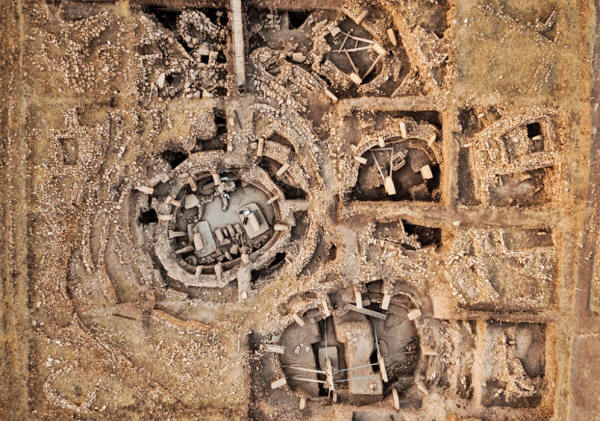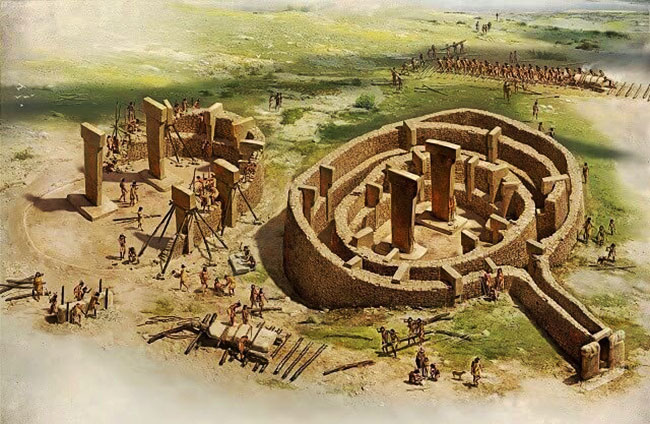|

June 02, 2018
from
CoolInterestingStuff Website

Aerial view of
Gobekli
Tepe's six structures
The recently (1995) discovered monolith at Gobekli
Tepe is clearly the worlds biggest mystery.
When found, it appeared
to have been deliberately buried in sand, for reasons that still
remain unknown. What's even stranger is that carbon dating estimates
the site to be over 12,000 years old!
The precision carving used during the construction is completely
unexplainable.
So far just 5% of this
incredible site has been excavated.

Situated at the northwest edge of Mesopotamia in Southeastern
Turkey, Gobekli Tepe is a tell, that is, an ancient manmade hill
built from the accumulated layers of millennia of building atop the
ruins of those who came before.
At the lowest level, its
most significant construction dates back to 10,000-11,000 BC, a
period that predates the introduction of writing, metal tools and
the wheel in the region by 6,000 years.
Armed with only the
simplest technology, the ancient builders used 'stone
tools' to chip enormous blocks of limestone into pillars,
each weighing between 11 and 22 tons.
Then hundreds of
people would work together to move the pillars anywhere from
100-500 meters to the complex.
At the site, the large stones were arranged in circular rings of
approximately eight upright pillars, each. Every pillar is
comprised of two stones that form a T shape.
Typically, six
pillars, connected with low walls, are set around the
circumference, and two taller pillars are situated in the
center. The tallest pillars reach16 feet in height, and the
largest rings are 65 feet in diameter.
To date, nearly 200
pillars have been found at the dig.
Across the world and
across time, man has enjoyed building large monuments.
To give you an idea of
just how old Gobekli Tepe is, consider the following timeline:
-
1644 AD -
Construction on the Great Wall of China ended with a total
length in excess of 20,000 km.
-
1400-1600 AD -
The
moai on Easter Island were
erected.
-
1372 AD - The
Leaning Tower, in Pisa, Italy, was completed after 200 years
of construction.
-
1113-1150 AD -
The Khmer of Southeast Asia built the enormous temple to
Vishnu, Angkor Vat.
-
200 AD - The
Pyramid of the Sun in Teotihuacan, Mexico was completed.
-
220 BC -
Construction on the Great Wall of China began.
-
432 BC - The
"apotheosis of ancient Greek architecture," the Parthenon,
was completed.
-
3000-1500 BC -
About 5,000 years ago, a group of crazy Neolithic Britons
hauled enormous four-ton stones over 140 miles to erect
Stonehenge on Salisbury Plain.
-
2550-2580 BC -
Pharaoh Khufu's tomb, the
Great Pyramid of Giza, was
completed. It remained the tallest manmade construction
until 1311 when the Lincoln Cathedral in England was
completed.
-
4500-2000 BC -
Pre-Celts cut and placed over 3,000 stones in Carnac,
France.
-
9130-8800 BC -
The first 20 round structures at
Gobekli Tepe were built.
Gobekli Tepe Alien
Evidence
Gobekli Tepe, which is actually a complex comprised of many temples,
may have been the first temple in the world made by man.

Evidence found at the
site shows that it was used for 'religious' purposes.
Most of the pillars
located there are T-based, up to 6 meters high, and have different
kind of animals (bulls, snakes, foxes, cranes, lions, etc) carved
into them.
The most astonishing thing is that some pillars weigh between 40-60
tons, causing speculation as to how it was possible for prehistoric
men to have built such a monument when basic tools had not yet been
invented.
According to archaeology,
people of that era were considered to be unsophisticated hunters.
The importance of Gobekli Tepe lies in the fact that the people who
lived there were much more advanced than previously imagined.
Proponents of
Ancient Astronaut Theory maintain
that beings from another planet could have aided mankind in these
ancient times and enabled them to create impressive structures not
just in Turkey, but in many countries throughout the world.
"Gobekli Tepe changes
everything," says Stanford University's Ian Hodder.
Ancient Aliens
If Ancient Aliens visited Earth, can evidence of their existence be
found in the mysterious structures that still stand throughout the
world?
Inexplicably, megalithic
structures found on different continents are strikingly similar, and
the cutting and moving of the massive stones used to build these
magnificent feats would be a struggle for modern day machinery, let
alone ancient man.
Ancient Astronaut
theorists suggest that the standing stones
in Carnac, France were
used as an ancient GPS system for
ancient flying machines.
The recently discovered
Gobekli Tepe in Turkey, which has been dated back 12,000 years, has
finely chiseled pillars that experts describe as a Noah's Ark
in stone.
-
Is it possible
that extraterrestrials assisted primitive man in
constructing these unexplained structures?
-
If so, what was
the purpose of these grand projects?
History is
wrong
Furthermore, many have proposed that Gobekli Tepe can even be a
temple inside the biblical Eden of Genesis.
Is it possible that
what we know about the ‘uncivilized and primitive' prehistoric
men is not at all true?
Is it possible that
advanced civilizations existed before 6000 BCE and their tracks
are simply lost in time?
Or is it possible
that extra-terrestrials interfered and helped men to build
monuments throughout the history of humanity?
The questions are
certainly compelling.
Man was supposed to have been a primitive hunter-gatherer at the
time of the sites' construction. Gobekli Tepe's presence currently
predates what science has taught would be essential in building
something on the scale such as those structures.
For instance, the site
appears before the agreed upon dates for the inventions of art and
engravings; it even predates man working with metals and pottery but
features evidence of all of these.
So who is
responsible for the construction of this compelling megalithic site?
Science is having a hard enough time with the dating of Gobekli Tepe.
According to scientific
methodology a true culture should not have existed that far back in
time. Trying to identify who should be credited with the site is no
easy task.
But while science stands confounded by this discovery, Ancient Alien
theorists have no problem stepping in and delivering who they
believe built the site.
For them it is so
obvious.
Aliens, or
extraterrestrials, are responsible for the construction of
Gobekli Tepe...
As more and more evidence
is uncovered from the site some of it compels archaeologists to
think Gobekli Tepe had been purposefully buried - to hide something,
but what and why...?
|




